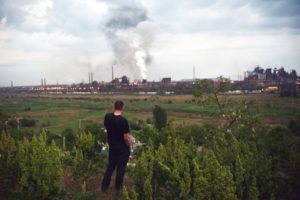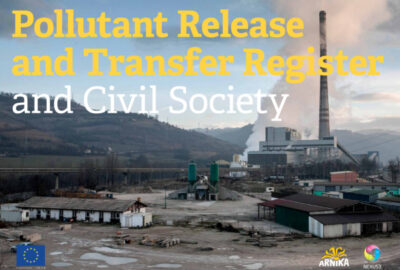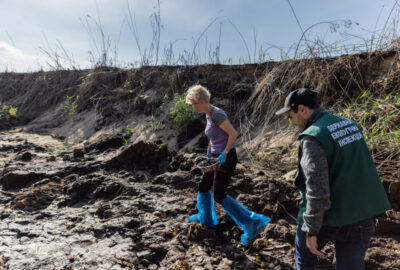A Czech-Ukrainian team of experts is examining the impacts of polluted air on the environment in the country. Analysing up to 90 samples of soil and river sediments in five major industrial cities – Dnipro, Kryvyi Rih, Zaporizhia, Kharkiv, and Mariupol (1) – will bring exact data on the depth of the issue. Ukraine suffers from severe air contamination causing tens of thousands of deaths a year (2), while it is the twelfth-largest steel producer in the world out of 67 countries (3). The results are expected to be published in November.
The Czech environmental organization Arnika teamed up with its Ukrainian counterpart Ecoaction in aid of five local initiatives. With support from the University of Chemistry and Technology, Prague, they are analysing sand from children’s playgrounds and also river sediments to present unique findings on the impact of the air pollution on the environment of the cities. Such independent research has never been carried out in Ukraine and there is no hard data available on the seriousness of the problem.
“There is a lack of reliable laboratories in Ukraine, and the pollution of the environment is a sensitive topic. The main suspects in air pollution are the factories owned by the semi-state companies, local oligarchs, or global corporations. That is why we are afraid that any kind of research carried out by our authorities or a local company might be manipulated because of the high level of corruption in Ukraine. The presence of foreign partners guarantees independent results,” explains Tamara Kharchylava, a lawyer from the Kyiv-based non-governmental organization Ecoaction.
Suffocating cities strike back
All of the cities that were monitored are centres of Ukrainian heavy industry, mainly homes to steelworks, metal and coal mines, or thermal power plants.
“Kryvyi Rih is currently one of the most polluted places in the country,” states Anna Ambrosova from the organization Stop poisoning Kryvyi Rih. The city is often referred to as the “Steel Heart of Ukraine” as the majority of all Ukrainian iron ore gets extracted here. The local metal-processing plant, the global corporation ArcelorMittal, is the largest steel producer in the world and one of the main culprits to blame for air pollution in Kryvyi Rih.
Many of the enterprises in question are owned or controlled by the richest men of Ukraine – for example, Viktor Pinchuk, or the wealthiest of them all, Rinat Akhmetov. Through his holding Metinvest Group, Akhmetov controls, among others, the fourth-largest steel-producing company in Ukraine, Zaporizhstal, and also the steelworks in Mariupol, the Dnipro heating plant, and mines in Kryvyi Rih.
Maxim Borodin, Deputy of the Mariupol city council (of the Power of the People political party), has been organizing a series of public events since 2012 in order to push the representatives of Metinvest towards a significant improvement of the situation at the Illich Steel and Iron Works sinter plant. Eventually, they succeeded. “At present, a general reconstruction and installation of a modern system of gas treatment facilities are taking place. However, same obsolete parts of the enterprises are still operating fully,” Borodin complains.
The fierce community protests are understandable. Polluted air causes severe health issues to the people, as activists from Kharkiv, home to Termolife Ltd. and the Koksohim coke plant, proved. By comparing medical records, pensioner Olena Reshetko discovered the correlation with the widespread occurrence of bronchitis, asthma, and cancer among local people (4).
Grimm statistics on pollution-related deaths
Ukraine suffers from one of the worst air pollution levels in the world. Sampling of selected areas will provide more and deeper information on the often lethal issue. According to the data of the WHO, every year Ukraine sees around 60,000 deaths caused by air pollution. Heavy industry, often built almost a hundred years ago and with very few environmental improvements to date, is largely to blame for the poisonous air in Ukrainian agglomerations.
“The samples that have been collected will be analysed for heavy metals and selected organic pollutants. Our research will try to find out to what extent the polluted air has an impact on the general state of the environment in industrial cities,” explains Martin Skalský, the Executive Director of the Citizens Support Centre of the Czech association Arnika. The research is supported by the Transition Promotion Programme of the Czech Republic.
PHOTOGALLERY: Czech experts investigate the environmental impact of air pollution in Ukraine
Notes for editors:
(1) Five major industrial cities of Ukraine
Not only the city of Dnipro, but almost the entire Oblast of Dnipropetrovsk is heavily polluted. The environmental situation in the region is characterized as an emerging crisis. Gross pollutant emissions in the air exceed one tonne per year. The region is dominated by the mining industry; the concentration of plants in the region is very high and the level of environmental safety of the equipment and the cleaning systems is extremely low. Read more…
Residents of the city of Kharkiv have suffered from extreme air pollution for many years. Those most affected are the inhabitants of the Novobavarskyi district in the western part of the city. The two largest polluters are located in the valley at the confluence of the Udy and Lopan rivers: the Kharkiv Coke Plant, built in the 1930s with technology that is now extremely obsolete, and the Termolife Mineral Wool Plant, put into operation in 2006. Both plants have the same owners. Read more…
The city of Kryvyi Rih is almost 100 km long but only 20 km wide and is considered to be the longest city in Europe. It is also called “the steel heart of Ukraine.” Historically, the city has been connected with metallurgy and iron mining. In 1934, the Kryvorizhstal complex (Kryvyi Rih Metallurgical Works) was built. The plant was privatized for the first time in June 2004 and then sold in June 2005 to the global company Mittal Steel. In 2007, the plant was renamed ArcelorMittal Kryvyi Rih. Read more…
There are more than 50 large enterprises in Mariupol, and this leaves the city of 462,000 inhabitants extremely vulnerable to air pollution, and, economically, dependent on a single oligarch, Rinat Akhmetov, who owns almost all of Mariupol’s industry. Akhmetov is the wealthiest man in Ukraine. He is the major shareholder of the Metinvest Group – a vertically integrated Ukrainian group of steel and mining companies – and the owner of the two largest metallurgical plants in Ukraine, both based in Mariupol: the Azovstal iron and steel works and the Ilyich iron and steel works. Established during the Soviet era, in the early 1930s, both plants are extremely technologically obsolete, with outdated equipment lacking environmental safety controls. Read more…
Zaporizhia has been one of the largest industrial centres of Ukraine since the beginning of the Soviet Union. Thanks to the available reserves of coal, iron ore, and manganese, engineering, heavy industry, metallurgy, the chemical industry, automobile production, and aircraft engines are concentrated here. The industrial part of Zaporizhia is located in the northeast of the city, the residential area in the south. The Soviet engineers did not consider the direction of the wind and therefore winds from the north-east regularly carry harmful substances directly into the residential areas. Read more…
(2) According to the data of the World Health Organization, Ukraine ranked first in mortality from air pollution per capita, with 120 deaths per ten thousand inhabitants in 2012. China tops WHO list for deadly outdoor air pollution (TheGuardian.com)
(3) World Steel Association: Major steel-producing countries in 2016 and 2017 (Worldsteel.org)
(4) Together with other activists, Olena Reshetko requested official statistics from the Kharkiv clinics for different types of illnesses of adults and children in the years 2010, 2011, 2012, and 2013, and then examined the situation in different parts of the city. When comparing Kharkiv Clinic No. 22 in the Chervonozavodskiy district (which is adjacent to the Zhovtnevyi district, where the Kharkiv Coke Plant and Termolife are situated) with Kharkov Clinic No. 9, located 10 km from the plants, it turned out that the occurrence of pulmonary and bronchial disease in adults is almost 3078 times higher than in the area distant from the city. For other diseases, the difference is 15-20 times higher.
“People here cannot rely on the authorities, the ministry, or environmental inspection. But I wanted to understand what’s going on in my neighbourhood and what exactly is killing us. So I decided to use my accounting skills,” describes Olena Reshetko over a huge folder of her long-term research. Read more…








